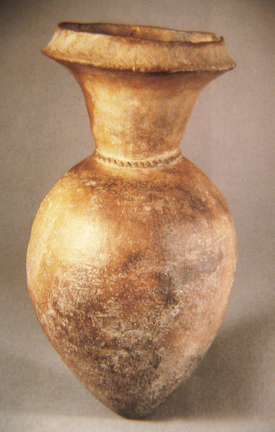
YAYOI STORAGE VESSEL, JAPAN,
400 BCE - 300 CE
ART 198 - HISTORY OF WORLD CERAMICS
| Following Jomon, the next oldest pottery from Japan is Yayoi (400 BCE - 250 CE), named after the district in Tokyo where the ware was first discovered in excavations in 1884. Yayoi pottery was produced by a new wave of immigrants from mainland China who arrived around 300 BCE. These people were farmers who developed iron tools and weapons, unlike the Jomon who used stone tools. Like the Jomon pottery, Yayoi ware was produced without the use of a wheel, and was coil built. The forms are simpler than Jomon as well, with little decoration. Note the fire markings on the ware, indicating that the pottery was fired using pit kilns. Unlike the preceeding Jomon people who were Caucasian, the Yayoi were Mongolian, related to Chinese and Southeast Asian ancestors, and it was the Yayoi who are the forebears of modern Japanese in ancestry. | YAYOI STORAGE VESSEL, JAPAN, 400 BCE - 300 CE |
|
|